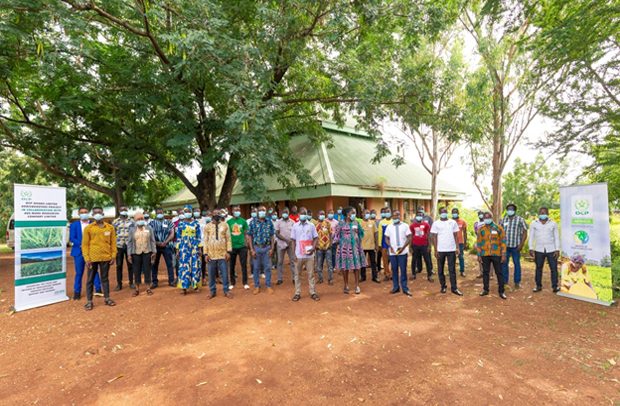Some of the farmers after the workshop
OCP AFRICA has organised a four-day training programme for 200 Agricultural Extension Agents (AEAs) from the Ministry of Food and Agriculture (MoFA) and some aggregators in the Bono East, Upper East, Upper West, North East, Ashanti, Oti and Eastern regions.
This falls within the framework of the partnership agreement signed between OCP Africa and Ministry of Food and Agriculture (MoFA) in September 2019 and as part of the agribooster programme.
The training was aimed at building capacities of the AEAs in line with OCP Africa’s 2020 Agribooster Campaign. The training provided participants with knowledge, tools and skills on farmer dynamics, Good Agricultural Practices (GAP), farming as a business (Business skills), post-harvest operations, and marketing of harvested crops among others.
Samuel Oduro, Country Manager of OCP Africa Ghana, said, “Aside the provision of farm inputs in the agribooster programme, we at OCP Africa believes the success of the programme partly depends on building the knowledge base of Agricultural Extension Agents (AEAs) who will transfer the knowledge gained to smallholder farmers.”
He added that OCP’s women in agribooster programme has also supported about 5,000 women smallholder farmers cultivating maize and rice with 1,250 metric tonnes of improved fertilisers, land preparation services and agricultural transformation equipment, with expected yield of 5,000 metric tonnes.
Ashanti Regional Director at MoFA, Rev. John Manu, said, “The dynamism in the agricultural landscape and the impact of COVID-19 on agriculture makes this training programme very vital for Extension Agents and Farmer Aggregators in the country.”
The 2019 Agribooster Campaign trained 87 extension officers, 400 lead farmers and 42,605 smallholder farmers on Good Agricultural Practices. Additionally, 3,700 metric tonnes of NPK fertilisers were supplied to 14,800 smallholder farmers cultivating a total of 37,000 acres. Their yields increased from 1.8 metric tonnes per hectare to 2.6 metric tonnes per hectare, representing an increase of 44%.


